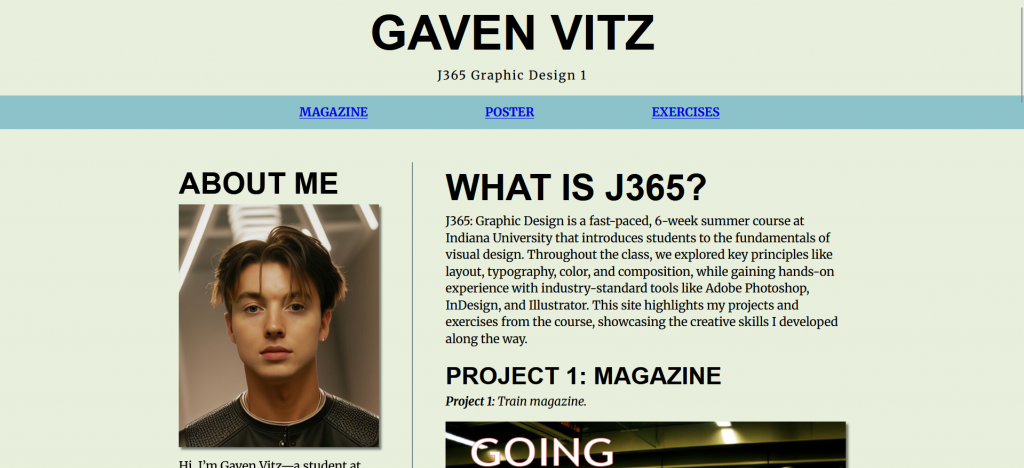
This project was a good recap for everything we’ve accomplished this summer. It was pretty smooth to complete with the tutorials and easy to make changes to our taste. I hope everyone enjoys the rest of their summer!

This project was a good recap for everything we’ve accomplished this summer. It was pretty smooth to complete with the tutorials and easy to make changes to our taste. I hope everyone enjoys the rest of their summer!
My poster goal was to market the beauty of the Philippine Blue Angelfish and raise awareness to a 40% off deal. This fake event would be on a timely basis showing the limited-time offer marked in a bold and easy to read format. I had an aim that the poster should be modern and minimal and have a good flow.I started by drawing one of my own angelfish in Adobe illustrator, so that the design could be viewed as more personal and real. I focused on leading lines in the fins to assist in guiding the eye on the picture. I colored the drawing using a monochromatic color scheme created by adobe. Then I imported the drawing to Photoshop to clean it up and save it as a PSD file. The reason why I did this was to make the final layout in InDesign,where I concentrated on the type and spacing (I find it the easiest here). Among the deliberate decisions, one was to make the shape of a triangle, which also makes a sort of a directional flow towards the upright title, thus contributing to defining the visual background of the whole composition. I think that the most powerful aspect of the work is that headline, as it identifies the piece immediately. Vertical composition, the shape of a triangle, and directional lines on the fish form a natural flow that the viewer can follow. It renders the design to be harmonious and self-assuredThe greatest difficulty was how far to take on the visual detail without overloading the statement. I was inclined to minimalism, and in the future, I would like to develop and incorporate some sort of soft texture or even some background images to enhance the composition with the layout remaining open. All in all, I am proud of the poster. This project allowed me to develop my skills in combining several tools and programs, such as Illustrator, Photoshop, and InDesign, in a single workflow, and realize that well-thought choices can direct the experience the viewers have.
My goal was to create a visually engaging and informative magazine that highlights the impact of design history—especially through Harry Beck’s Tube map. I believe the final product achieves this, offering clear storytelling paired with strong visuals.
I used clean, modern fonts for readability and chose a muted color palette to give the magazine a timeless, professional feel. Images—especially of Beck’s map—were central to the layout, helping guide the reader through the narrative visual
This project gave me a deeper understanding of how thoughtful design decisions can enhance storytelling. One of my goals was to create a consistent visual language that tied the magazine together, and while I achieved that in many ways, I also ran into challenges that taught me valuable lessons.
A major success was the intentional use of red and cream tones throughout the magazine. These colors were inspired by the vintage train on the cover and helped establish a retro yet bold aesthetic that connected with the historical focus of the Harry Beck story. Carrying that color scheme across different pages gave the magazine a cohesive tone and subtly reinforced the subject matter without needing to say it outright.
In the map evolution section, I used colored lines that mirrored the actual Tube line colors found in Beck’s diagrams. That design choice wasn’t just decorative—it was meant to echo the visual structure and clarity that made Beck’s map so iconic. It helped visually tie the reader back to the concept of simplification and design efficiency, which was a core theme of the article.
However, not every design decision was successful. I struggled with margin consistency, which made some pages feel slightly off-balance. It’s a small detail that has a big impact on how professional a spread feels, and I now see the importance of double-checking these layout basics. Another area that didn’t meet my expectations was the silhouette of the blurry man on the cover. It was meant to add mystery and atmosphere, but the execution fell short—it looks more like a flaw than a design choice. Next time, I’ll refine my image editing and be more intentional with how effects like blur are used. Not to mention I mistakenly made the cover across an entire spread!
Overall, I learned that subtle details—like color matching, spacing, and visual references—make a big difference in the user experience. I also learned to critique my work more honestly and recognize when something isn’t working visually. In the future, I plan to push my design skills further by exploring more refined layout structures and becoming more detail-oriented with spacing and imagery.